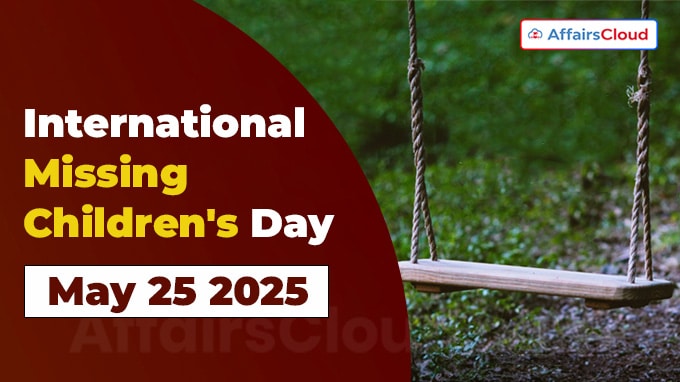 International Missing Children’s Day (IMCD) is annually observed across the globe on May 25 to raise awareness about the issue of missing children, promote child safety, and highlight efforts to protect children from abduction, trafficking, and exploitation.
International Missing Children’s Day (IMCD) is annually observed across the globe on May 25 to raise awareness about the issue of missing children, promote child safety, and highlight efforts to protect children from abduction, trafficking, and exploitation.
- The day is symbolized by the “forget-me-not flower”, representing hope for reuniting missing children with their families.
Background:
i.Former President of the United States of America (USA) Ronald Reagan officially designated 25 May 1983, as the first National Missing Children’s Day to commemorate the disappearance of Etan Patz, a six-year-old boy who vanished from a street corner in New York City (USA) on May 25, 1979.
ii.IMCD began in 1998 through a partnership between the International Centre for Missing & Exploited Children (ICMEC) and the USA-based National Center for Missing & Exploited Children (NCMEC).
iii.In 2001, May 25th was officially recognized as the first IMCD, achieving worldwide recognition through the collaborative efforts of ICMEC, the European Commission, and Missing Children Europe.
Missing Children Statistics in India (2020-2024):
i.According to the National Crime Records Bureau (NCRB)under the Ministry of Home Affairs (MHA), nearly 3 lakh children were reported missing during this period.
- 3 of every 4 missing children in India are girls.
ii.About 36,000 children remain untraced, indicating enforcement challenges.
iii.State-wise ranking:
- Among the states, Madhya Pradesh (MP) recorded the highest number with 58,665 missing children, out of which 45,585 have been recovered, leaving 3,955 still missing.
- Bihar and Odisha follow next in terms of the number of missing children.
Initiatives in India:
i.Anti-Human Trafficking Units (AHTUs): AHTUs are being reinforced across all districts to combat trafficking more effectively.
ii.Crime Multi Agency Centre (Cri-MAC): Development of a coordinated, online data-sharing platform among law enforcement agencies to facilitate real-time communication and information exchange.
iii.Childline 1098 and Railway Childlines: The Ministry of Women and Child Development (MoWCD) operates a 24×7 helpline for children in distress and transit point protection through Railway Childlines.
iv.TrackChild Portal: The MoWCD initiated the Track Child Portal to help locate missing and found children across all States and Union Territories.
- It is implemented with support from the MHA, Ministry of Railways (MoR), State Governments/Union Territory (UT) Administrations, Child Welfare Committees (CWC), Juvenile Justice Boards, and the National Legal Services Authority (NLSA).
v.The Khoya-Paya portal: Developed by the MoWCD and the Department of Electronics and Information Technology (DeitY), under Ministry of Electronics and Information Technology (MeitY), is a citizen-driven website that allows any Indian citizen to register and report information about missing and found children.
vi.Mission Vatsalya Scheme:
Mission Vatsalya Scheme, is a Centrally Sponsored Scheme(CSS) introduced by the MoWCD, carried out by the States and Union Territories (UTs).
- Its main goal is to provide support to Children in Need of Care and Protection (CNCP) and Children in Conflict with Law (CCL).
vii.Standard Operating Protocol (SOP): MWCD has issued SOPs for police, child welfare committees, and juvenile justice boards to streamline rescue and rehabilitation.
About International Centre for Missing & Exploited Children (ICMEC):
Secretary General – Stephen Kavanagh
Headquarters – Virginia, United States of America (USA)
Established – 1998




